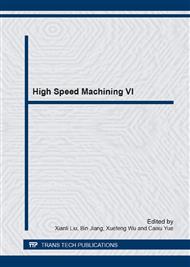p.269
p.275
p.280
p.285
p.290
p.296
p.300
p.305
p.311
Study on Finite Element Simulation of the Influence of Cutting Speed on Chip Formation of SiCpAl Composites in High Speed Milling
Abstract:
Application prospect of the high volume fraction SiCp/Al composites becomes increasingly widespread, the study of cutting mechanism is important for achieving its high efficient and precision machining. In this paper, a three-dimensional beveled simulation model of high volume fraction SiCp/Al composites on high-speed milling is established by finite element software ABAQUS, the constitutive on model material, the tool-chip contact and the chip separation model is elected reasonably.The paper analyzes the effect of cutting speed on the chip formation and the stress distribution of the material. The results shows that: with the increasing of cutting speed, the chip is easily broken, cutting speed have little impact on the maximum stress of the material.
Info:
Periodical:
Pages:
290-295
Citation:
Online since:
July 2014
Authors:
Price:
Сopyright:
© 2014 Trans Tech Publications Ltd. All Rights Reserved
Share:
Citation:


